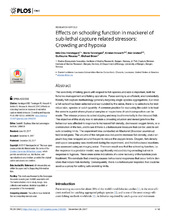| dc.contributor.author | Handegard, Nils Olav | |
| dc.contributor.author | Tenningen, Maria | |
| dc.contributor.author | Howarth, Kirsten | |
| dc.contributor.author | Anders, Neil | |
| dc.contributor.author | Rieucau, Guillaume | |
| dc.contributor.author | Breen, Michael | |
| dc.date.accessioned | 2018-07-31T09:21:32Z | |
| dc.date.available | 2018-07-31T09:21:32Z | |
| dc.date.issued | 2017-12-28 | |
| dc.Published | Handegard NO, Tenningen MM, Howarth, Anders N, Rieucau G, Breen M. Effects on schooling function in mackerel of sub-lethal capture related stressors: Crowding and hypoxia. PLoS ONE. 2017;12(12):e0190259 | eng |
| dc.identifier.issn | 1932-6203 | en_US |
| dc.identifier.uri | https://hdl.handle.net/1956/17910 | |
| dc.description.abstract | The selectivity of fishing gears with respect to fish species and size is important, both for fisheries management and fishing operations. Purse seining is an efficient, environmentally friendly fish capture methodology generally targeting single species aggregations, but once a fish school has been selected and surrounded by the seine, there is no selections for individual size, species or catch quantity. A common practice for evaluating the catch is to haul the seine to a point where physical samples or inspections of catch composition can be made. The release process is called slipping and may lead to mortality in the released fish. The objective of this study was to simulate a crowding situation and investigate how the behaviour was affected in response to increased fish density, decreased oxygen levels, or a combination of the two, and to see if there is a behavioural measure that can be used to set safe crowding limits. The experiment was conducted on Mackerel (Scomber scombrus) held in net pens. The volume of the net pen was reduced to increase fish density, and a tarpaulin bag was wrapped around the pen to reduce the oxygen levels. Oxygen, fish density and space occupancy was monitored during the experiment, and the behavioural reactions was assessed using an imaging sonar. The main result was that the schooling function, i.e. the response to a predator model, was significantly reduced during crowding but not in response to hypoxia. There were some indications of a slow recovery of the function post-treatment. We conclude that crowding causes behavioural responses that occur before densities that induce fish mortality. Consequently, there is a behavioural response that could be used as a proxy for setting safe crowding limits. | en_US |
| dc.language.iso | eng | eng |
| dc.publisher | PLoS | en_US |
| dc.rights | Attribution CC BY | eng |
| dc.rights.uri | http://creativecommons.org/licenses/by/4.0 | eng |
| dc.title | Effects on schooling function in mackerel of sub-lethal capture related stressors: Crowding and hypoxia | en_US |
| dc.type | Peer reviewed | |
| dc.type | Journal article | |
| dc.date.updated | 2018-03-15T09:22:40Z | |
| dc.description.version | publishedVersion | en_US |
| dc.rights.holder | Copyright 2017 The Author(s) | en_US |
| dc.identifier.doi | https://doi.org/10.1371/journal.pone.0190259 | |
| dc.identifier.cristin | 1563956 | |
| dc.source.journal | PLoS ONE | |

